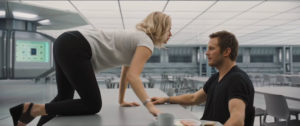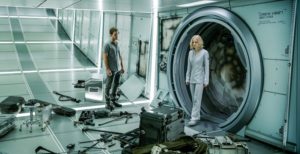
After a sleep pod malfunction awakens two passengers (Chris Pratt and Jennifer Lawrence) 90 years early, they must face a lonely future on a spacecraft traveling to a distant colony.
The biggest challenge for the crew was creating a craft that was exciting and fresh to look at. Director Morten Tyldum’s specific directive to production designer, Guy Hendrix Dyas and his art department was that if he had an environment, he wanted the actors to be in it, to feel it, so the viewer could feel their loneliness and emotions. Consequently, all the space ship interiors were built.
“Everything that you see in that movie that was an interior environment was a real set. Absolutely everything,” stated Dyas. “Visual effects on this particular film was used very much as a support, as a way of extending the set, if we needed to extend it.”
An example of a set with a VFX extension was the grand concourse, a large shopping mall. Only two levels were built – the ground floor, and the first floor up where Lawrence jogs. The design envisioned a five-story structure with a huge glass dome ceiling. Visual effects added the three stories and dome above the “colossal” construction, which was 350 feet long. Another example of a set extension was the cafeteria, where a limited section with all the seating was constructed that VFX then extended “off into infinity.” Other interior sets were 100% built using seven stages for production.
When the search for a location in Atlanta that had a pool that looked like a spa was exhausted, the art department actually had to build the swimming pool in a dirt parking lot at Pinewood studios because no stages were available. The team had already started to design a pool as a back-up, so when the producers gave a green light for the build a mere four weeks before shooting, construction of the pool was up and running in a few hours.
By the time the pool was completed set decorator, Gene Serdena, was up against the clock. “Poor Gene on this film,” commented Dyas. “Honestly, if there is something to say about Gene and his extraordinary team, it’s that they always had a mere beat to decorate a lot of these sets. The time frame on this film was very fast. He worked tirelessly, day and night, to get this done. His team also put together some of the wonderful machines that we designed.”
The exterior of the ship was designed by Dyas and developed within the art department. They gave VFX a 3D model of the finished spaceship, which was then improved, tweaked and texture mapped before the sweeping shots of the craft were designed. Dyas’ overall concept for the spacecraft was to make it real, organic and based upon science. With recent films like The Martian, Interstellar, Gravity, he believes audiences are sophisticated in their expectations for science fiction movies.
“I wanted to continue that train of thought in terms of thinking about the science aspect of the design, but at the same time, our spaceship is hundreds of years in the future, so I really could not follow the atypical NASA aesthetic. It had to be something new,” explained Dyas. “What I had to do was combine a very futuristic looking ship together with feasible science.”

Dyas was also “on a personal mission” to break the idea that the look of a spaceship would be the same throughout. In this script, the design was based upon a cruise liner and the idea that the ship was an entertainment center, not just a means of traveling across space. This afforded the opportunity for him to make the interior spaces look very different. The grand concourse was sleek, white and made of steel, all the things expected in a spaceship, but the bar had an art-deco period design with warm colors and stained glass panels, giving the audience a “visual jolt.”
“One of the things I did to make the design different was to embellish it with lots of great details. The color is extremely rich. Lots of purples and reds and golds and oranges, so that you got a sense that this is a place you want to be,” shared Dyas.
The purview of the art department also included creating the machine-like, Cyclops-style robots, a design that needed to be look harmless and friendly, void of humanistic features. The only other human element in the script was Arthur (Michael Sheen), the barman, because Pratt’s character needed to feel very lonely from the lack of any other humanoid or android-style robot contact.
Dyas loves working on films in the U.S. because he is able to work with the best artisans and crafts persons in the world. For their “above and beyond” collaboration in trying to make the film a “visual spectacle,” Dyas credited his team. “David Lazan was the supervising art director. We had a wonderful illustration team who took a lot of my pencil sketches and developed them into these really beautiful designs. People like Ed Natividad, Tommy Tunitaki – really fantastic talents. Dean Walcott, the set designer, handled a lot of the design for the more tech areas of the space ship. Josh Lusby did a stunning job realizing the design for the Vienna suite, which was our most prized ‘hotel’ room, so to speak, on the ship. In Los Angeles, senior art director Luke Freeborn oversaw the construction of all the pods and the auto-doc that were shipped out to Atlanta.”
The level of finishes were so high that the real environments could have been mistaken for CGI. According to Dyas, “We had a remarkable construction team headed up by Bob Blackburn. His crew gave us those wonderful automotive quality paint finishes that make all the sets look gleaming and made of metal when actually everything is made of foam and wood. One of those tricks of the trade.”





